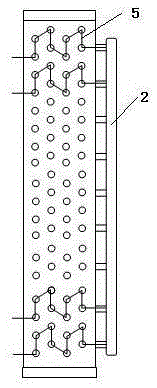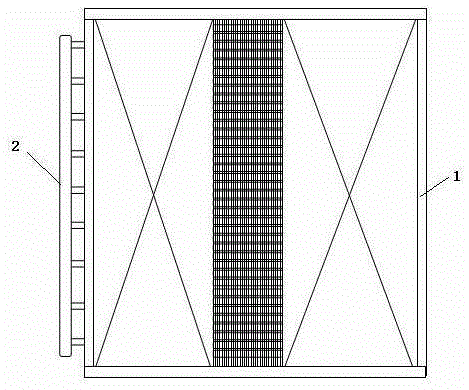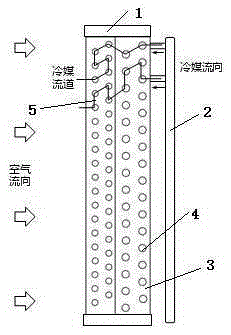Composite air-cooling pipe finned heat exchanger structure
A heat exchanger and tube-fin type technology is applied in the field of composite air-cooled tube-fin heat exchanger structures to achieve a balance between cost and heat transfer performance, small wind side resistance, and ease of cost and heat transfer performance. Effect
- Summary
- Abstract
- Description
- Claims
- Application Information
AI Technical Summary
Problems solved by technology
Method used
Image
Examples
Embodiment approach 1
[0025] see image 3 and Figure 4 , is a schematic diagram of two sub-air heat exchangers 3 connected in series, and the number of rows of copper tubes 4 in the sub-air heat exchanger 3 is two rows. The refrigerant channel passes through the copper tubes 4 with large and small diameters in sequence.
[0026] Under cooling conditions, the refrigerant flows out from the header 2 and first passes through the channel with a large pipe diameter. The refrigerant is in gaseous state, and the flow velocity decreases under the large pipe diameter. As condensation progresses, the specific volume of the refrigerant decreases. In the second half, the refrigerant enters the channel with a small diameter. At this time, due to the reduction of the cross-sectional area of the channel, the flow rate of the refrigerant will not be greatly reduced, thereby ensuring a certain flow rate in the tube and ensuring the heat exchange effect.
[0027] Under the heating condition, the flow direction...
Embodiment approach 2
[0030] see Figure 5 , is a schematic diagram of two sub-air heat exchangers 3 connected in parallel, and the number of rows of copper tubes 4 in each sub-air heat exchanger 3 is also different. The sub-air heat exchanger 3 below adopts a large pipe diameter and a two-row structure, and the air side resistance of the sub-air heat exchanger 3 is relatively small. The blower fan 6 is located at the top and is in the form of an upper air outlet.
[0031] For the form of upper air outlet, because the upper and lower structures of the traditional heat exchanger are consistent, the wind speed difference between the upper part and the lower part of the heat exchanger is relatively large, and the wind speed in the lower part is lower than that in the upper part, especially for the wind heat exchanger with V-shaped structure. As a result, the lower heat exchange area is not fully utilized, which affects the overall heat exchange effect. In the combined wind heat exchanger with parall...
Embodiment approach 3
[0034] see Image 6 , is a schematic diagram of three sub-air heat exchangers 3 connected in series, the number of rows of sub-air heat exchangers 3 is 1 row, and the heights of different sub-air heat exchangers 3 are inconsistent. The refrigerant channel passes through copper tubes 4 with three diameters of large, medium and small in sequence.
[0035] Compared with Embodiment 1, this structure has more sub-air heat exchangers 3, more diameter changes in the refrigerant channel, and a better consistency between the change of refrigerant flow rate and the change of refrigerant specific volume, so the resistance of the refrigerant and the heat transfer The balance effect is better. Moreover, because the fins have more discontinuities, the flow of air is more turbulent, which is beneficial to improve the heat exchange effect of the air side. The difference from Embodiment 1 is that the heights of the three air heat exchangers 3 in this structure are inconsistent, and the actua...
PUM
 Login to View More
Login to View More Abstract
Description
Claims
Application Information
 Login to View More
Login to View More - R&D
- Intellectual Property
- Life Sciences
- Materials
- Tech Scout
- Unparalleled Data Quality
- Higher Quality Content
- 60% Fewer Hallucinations
Browse by: Latest US Patents, China's latest patents, Technical Efficacy Thesaurus, Application Domain, Technology Topic, Popular Technical Reports.
© 2025 PatSnap. All rights reserved.Legal|Privacy policy|Modern Slavery Act Transparency Statement|Sitemap|About US| Contact US: help@patsnap.com



